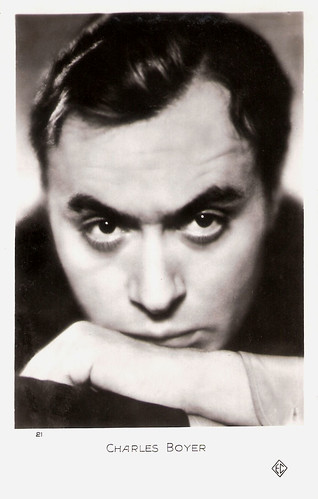
French postcard by EC (Editions Chantal), Paris, no. 21.

French postcard by A.N., Paris, no. 653. Photo: Metro Goldwyn Mayer.

French postcard by EC (Editions Chantal), Paris, no. 21. Photo: Ufa.

Italian postcard by Edizione ELAH in the series Artisti del Cinema, no. 100. Photo: Warner Bros. Publicity still for Tovarich (Anatole Litvak, 1937).
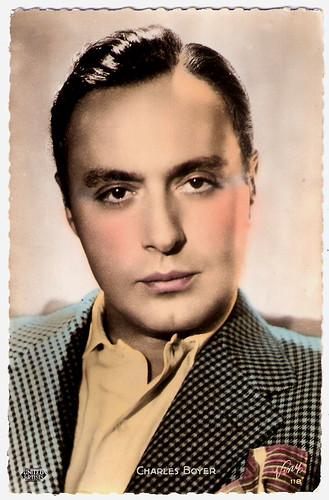
French postcard by Viny, no. 118. Photo: United Artists.
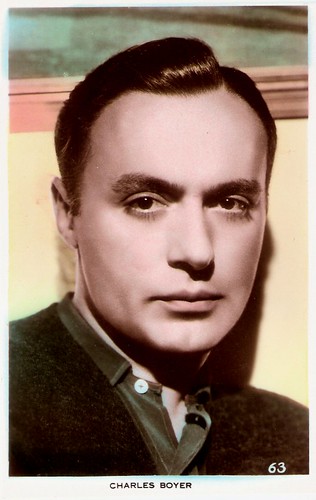
British postcard by Art Photo Postcard, no. 63.
Shy small-town boy
Charles Boyer was born in Figeac in the French Pyrenees in 1899 to Maurice and Louise Boyer. His surname comes from boièr, the Occitan word for "cowherd". Charles was just a shy small-town boy who discovered the cinema at the age of eleven.
Working as a hospital orderly during the First World War, he started to come out of himself performing comic sketches for the soldiers there. Boyer began studying philosophy studies at the Sorbonne while waiting for a chance to study acting at the Paris Conservatory.
In 1920, he replaced the leading man in a stage production, 'Aux Jardins de Murcie' and was successful. Then he appeared in the play 'La Bataille' and Boyer became a theatre star overnight. In the 1920s he became a popular ladies' man on the stage.
Boyer also appeared in silent films. His first film was L’homme du large/Man of the Sea (Marcel L'Herbier, 1920), starring Jaque Catelain and based on a short story by Honoré de Balzac. It was filmed on the rugged southern coast of Brittany creating the atmosphere in a film about the forces of good and evil that motivate human behaviour.
Nearly a decade later followed productions like La Barcarolle d'amour (Carl Froelich, Henry Roussel, 1929) with Annabella, and Le Capitaine Fracasse/Captain Fracasse (Alberto Cavalcanti, Henry Wulschleger, 1929) starring Pierre Blanchar. At first, he performed film roles only for the money and found that supporting roles were unsatisfying. However, with the coming of sound, his deep voice made him a romantic star.

British postcard in the Picturegoer Series, London, no. 1258. Photo: RKO Radio.

Italian postcard by C.C.M., no. 4. Photo: RKO Radio Films.
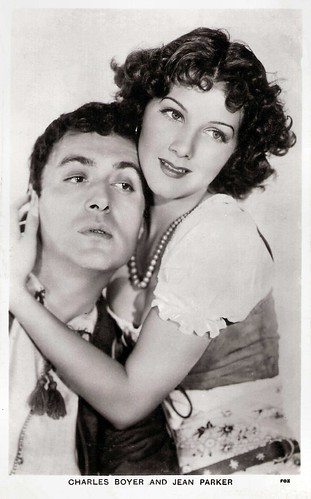
British postcard in the Film Partners Series, no. P 143. Photo: Fox. Publicity still for Caravan (Erik Charell, 1934).
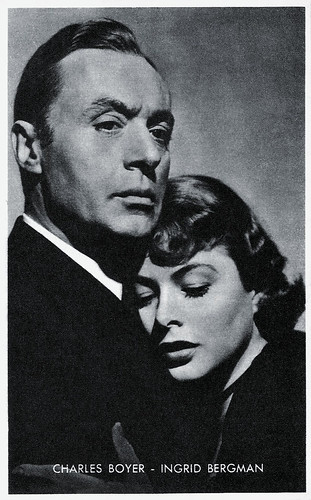
Belgian collectors card by Kwatta, Bois d'Haine, no. C. 176. Photo: M.G.M. Publicity still for Arch of Triumph (Lewis Milestone, 1948) with Ingrid Bergman.
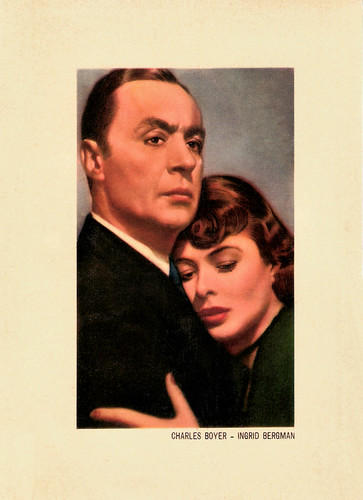
Belgian collectors card by Kwatta, Bois d'Haine. Photo: M.G.M. Publicity still for Arch of Triumph (Lewis Milestone, 1948) with Ingrid Bergman.
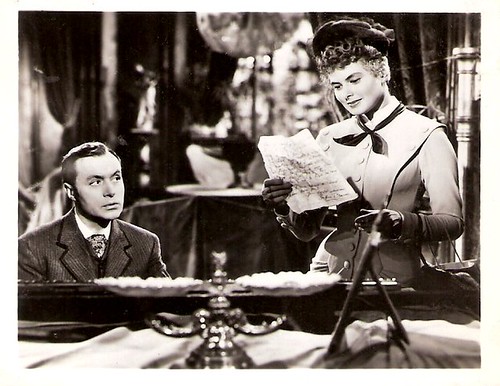
Small card. Photo: MGM. Photo: still from Gaslight (George Cukor, 1944) with Ingrid Bergman.
Suave and sophisticated beyond a woman's wildest dreams
In 1929 Charles Boyer was signed by MGM, but nothing came from this first Hollywood stay. But with the coming of sound, his deep voice made him a romantic star: suave and sophisticated beyond a woman's wildest dreams.
Back in Europe, he starred in productions like Tumultes (Robert Siodmak, 1932) and La Bataille (Nicholas Farkas, Victor Tourjansky, 1933) again opposite Annabella. In 1934, after starring in a French adaptation of Ferenc Molnár’s bittersweet fantasy play Liliom directed by Fritz Lang, he eventually decided to return to the USA.
He played his first major Hollywood role opposite Loretta Young in Caravan, the American version of the romantic musical Caravane (Erik Charell, 1934). He also played the lead in the French version, now opposite Annabella.
He continued to make European films such as the offbeat romance Le Bonheur/Happiness (Marcel L'Herbier, 1935) with Gaby Morlay. His role in the French historical love-drama Mayerling (Anatole Litvak, 1936) opposite Danielle Darrieux made him an international star.
Hal Erickson at AllMovie adds: "Transforming this grim story into a tender, moving romance was quite an undertaking, but the end result was worth it: Mayerling was a huge international hit, and the winner of several industry awards, including the New York Film Critics' 'best foreign picture' prize."
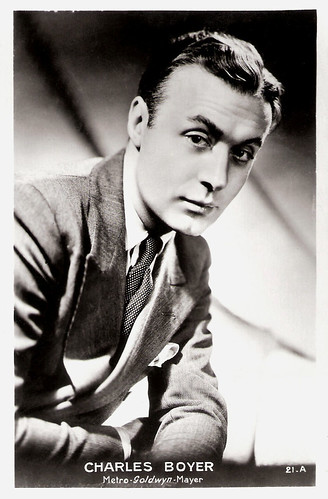
French postcard by Edition Chantal, Paris, no. 21 A. Photo: M.G.M.

French postcard by Editions P.I., Paris, no. 218. Photo: United Artists.
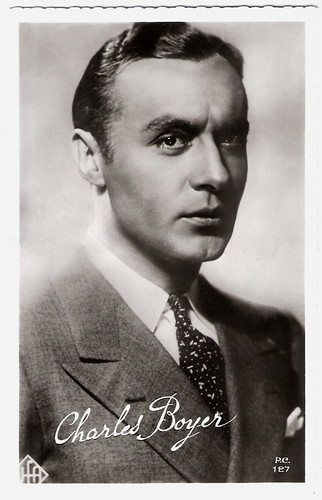
French postcard by P.C., Paris, no. 127. Photo: Ufa.

Dutch postcard by J. Sieding NV, Amsterdam. Photo: Universal-International.
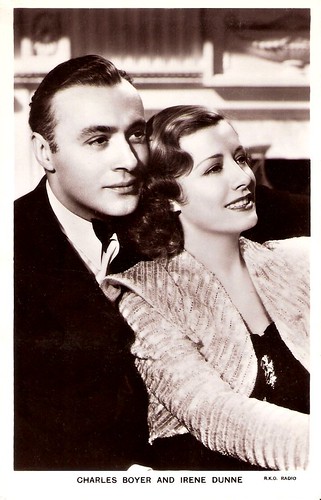
British postcard in the "Film Partners" Series, London, no. P 268. Photo: R.K.O. Radio. Publicity photo for Love Affair (Leo McCarey, 1939) with Irene Dunne.
Declarations of love
In the following years, Charles Boyer whispered declarations of love to Marlene Dietrich in The Garden of Allah (Richard Boleslawski, 1936), Jean Arthur in History Is Made at Night (Frank Borzage, 1937), Greta Garbo in Conquest (Clarence Brown, 1937), and Irene Dunne in the classic tearjerker Love Affair (Leo McCarey, 1939).
One of his most famous roles was Pepe le Moko, the thief on the run, in Algiers (John Cromwell, 1938) an English-language remake of the French film hit Pépé le Moko (Julien Duvivier, 1937) with Jean Gabin.
In 1942 Boyer became a naturalised citizen of the United States. After World War II, he continued his international career in films and on television, Broadway and the London stage. During his career, he was nominated four times for the Academy Award: for his parts in Conquest (1937), Algiers (1938), Gaslight (George Cukor, 1944) and Fanny (Joshua Logan, 1961), but he never won.
From 1952 till 1956 he moved into TV as one of the pioneering producers and stars of Four Star Playhouse. Onscreen, he continued to shine with older roles in Hollywood productions and European films like Madame de... (Max Ophüls, 1953) and Stavisky (Alain Resnais, 1974). The latter role won him the New York Film Critics Circle Award for Best Supporting Actor and the Cannes Film Festival Special Tribute. In 1948, France had already made him a Chevalier of the French Legion of Honour.
Boyer's distinguished career would last longer than other romantic leading men, and earned him the title of 'the last of the cinema's great lovers'. In real life, Charles Boyer was faithfully married for 44 years to British actress Pat Paterson whom he had met at a dinner party in 1934. In 1978, two days after his wife died from cancer, and two days before his 79th birthday, he committed suicide.

Hungarian postcard by Sztár Filmkepei, Bolt. Photo: Twentieth Century Fox.

French postcard by Viny, no. 50.
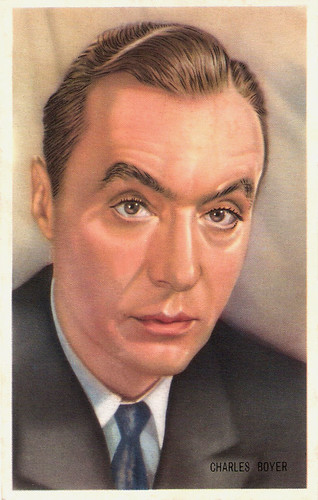
Belgian collectors card by Kwatta, Bois d'Haine, no. C. 112. Photo: M.G.M. Publicity still for Arch of Triumph (Lewis Milestone, 1948).
Charles Boyer's first scene in his first film, L'Homme du Large (1920). Source: Briyanshu (YouTube).
Charles Boyer sings C'est La Vie in Algiers (1938). Source: deidzoeb (YouTube).
Sources: Hal Erickson (AllMovie), Wikipedia and IMDb.
This post was last updated on 27 July 2023.
8 comments:
I loved this post! What an interesting man. His eyelashes are phenomenal--why do fellas always seem to have them? Tch tch tch...
And he was shy to begin with--that is true of many actors. Lovely post, Bob!
Happy PFF!
There's someone I remember!!! (Yikes) ... Boyer and Loretta Young. WOWOWOWOWOW!!!!!!!!!!
Happy PFF!
wonderful postcards here - the colour washes are absolutely gorgeous and it's nice to see the same image in black and white too.
He was the epitome of suave and sophisticated. An amazing screen presence. Surely not quite "beyond a woman's wildest dreams":-)
Yes, showing my age, I remember him too!! I can distinctly remember a phase when my grandmother's conversations would consist of a list of film stars who had recently died.
A name I know...so handsome. I look forward to your PFF blog entries.
Judy
Swoon.... I always liked Boyer - that deep voice, but also an expressive face. Even in his lesser films he stood out.
Happy Postcard Friendship Friday!
About a year ago the young Charles Boyer was featured in a blog. Charles Beyer young and handsome? What a surprise. I was "forced" to enjoy a few of his early movies to confirm that.
Post a Comment